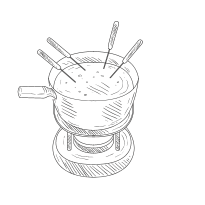Chocolate Fountains: A Cascading Wonder
A chocolate fountain is a centerpiece that commands attention. The sight of rich, melted chocolate flowing smoothly down tiers, tempting guests to dip and indulge, is a feast for the eyes as much as the taste buds. But have you ever stopped to wonder how this mesmerizing contraption actually works? The secret lies in a clever combination of engineering and the physical properties of chocolate itself.
Anatomy of a Chocolate Fountain
While designs vary, most chocolate fountains share these key components:
- Base: Provides a sturdy foundation for the fountain and often houses the heating element.
- Heating Element: Maintains the chocolate at the ideal temperature for flow and consistency.
- Basin: Holds the melted chocolate, forming the bottom tier of the fountain.
- Cylinder: A hollow, vertical tube running through the center of the fountain. The auger resides within.
- Auger: This spiral-shaped screw acts as the heart of the fountain. It rotates within the cylinder, drawing melted chocolate from the basin upwards.
- Tiers: Stacked platforms with strategically placed openings allow the cascading chocolate to flow gracefully downwards, creating the mesmerizing effect.
The Flow of Chocolate: Unveiling the Magic
The operation of a chocolate fountain is surprisingly straightforward, based on a continuous cycle:
- Melting and Preparation: The process begins by melting specially formulated fountain chocolate. This chocolate typically contains a higher proportion of cocoa butter, which provides the necessary fluidity at lower temperatures.
- Filling the Basin: The melted chocolate is poured into the fountain’s basin, ensuring it is evenly distributed.
- Engaging the Auger: Once the chocolate reaches the right temperature, the auger is switched on. It rotates within the cylinder, drawing the melted chocolate upwards from the basin.
- The Cascading Effect: As the chocolate reaches the top of the cylinder, it spills over, cascading down the tiers. The strategic design of the tiers ensures a smooth, continuous flow, creating the mesmerizing curtain of chocolate.
- Back to the Basin: The chocolate collected at the base of each tier eventually flows back into the basin, where it is drawn up again by the auger, perpetuating the cycle.
The Importance of Viscosity and Temperature
Maintaining the chocolate’s viscosity (thickness) and temperature is crucial for a successful fountain experience. If the chocolate is too thick, it won’t flow properly. If it’s too thin, it will create a messy, drippy spectacle.
Fountain chocolate is specially formulated to have a lower viscosity than regular chocolate, allowing it to flow smoothly at lower temperatures. The heating element within the fountain maintains this precise temperature, typically between 100°F and 110°F (38°C – 43°C), preventing scorching and ensuring optimal flow characteristics.
Beyond the Basics: Types of Chocolate Fountains
While the basic operating principle remains consistent, chocolate fountains come in various shapes, sizes, and levels of sophistication:
- Home Fountains: Compact and designed for occasional use, these fountains are perfect for parties and gatherings.
- Commercial Fountains: Larger and more robust, commercial fountains cater to high-volume use in settings like hotels, restaurants, and events.
- Tier Variations: Fountains come with different numbers of tiers, influencing the height and visual impact of the cascading chocolate.
- Specialty Fountains: Some fountains offer features like adjustable temperature controls, multiple dipping bowls, or even LED lights for added visual flair.
Tips for a Successful Chocolate Fountain Experience
To ensure your chocolate fountain is a show-stopping success, consider these tips:
- Choose the Right Chocolate: Always use specially formulated fountain chocolate for optimal flow and consistency.
- Proper Melting: Melt the chocolate slowly and evenly, following the manufacturer’s instructions carefully.
- Temperature Control: Monitor the temperature of the chocolate throughout the event to maintain its ideal viscosity.
- Dipping Delights: Offer a variety of dipping items, such as fresh fruits, marshmallows, pretzels, and cookies.
- Clean-Up: While cleaning a chocolate fountain might seem daunting, it’s manageable with warm water and a bit of patience. Most fountains disassemble for easier cleaning.
Conclusion: A Symbol of Indulgence and Celebration
More than just a dessert, a chocolate fountain is an experience, a captivating centerpiece that brings people together. By understanding the mechanics behind its mesmerizing flow, we can appreciate the ingenuity that transforms melted chocolate into a cascading work of edible art. So, the next time you encounter a chocolate fountain, take a moment to admire the engineering and artistry that makes this sweet spectacle possible. Then, grab a skewer, dip into the flowing goodness, and savor the moment.

